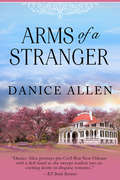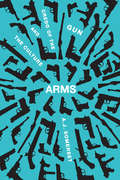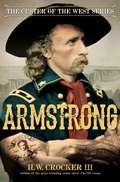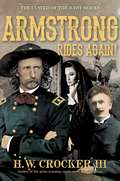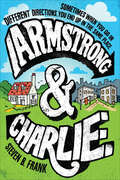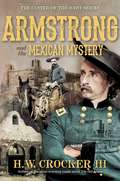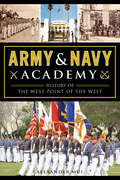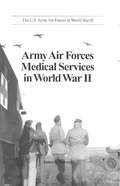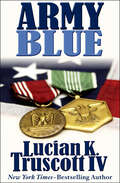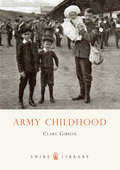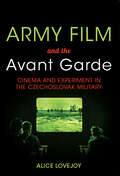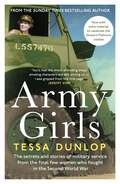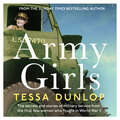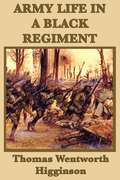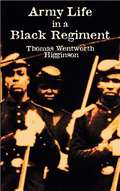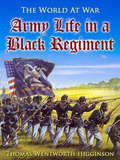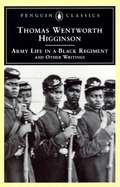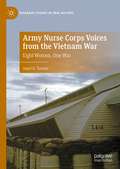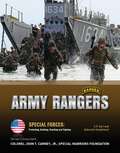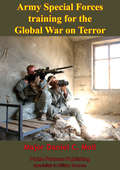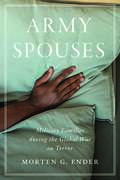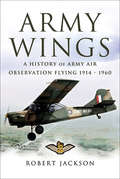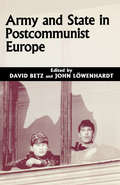- Table View
- List View
Arms of a Stranger
by Danice Allen“Danice Allen portrays pre-Civil War New Orleans with a deft hand as she sweeps readers into an exciting desire-in-disguise romance.” —RT Book Reviews Bored with the dull suitors and shallow admirers of London, Anne Weston sets out for New Orleans in search of a new kind of man. She finds what she’s looking for in the form of a brave stranger who helps a family of slaves escape—before pulling Anne into the shadows to steal a kiss. Lucien Delocroix, the careless, lazy son of a wealthy plantation owner, is more concerned with the cut of his coats than the running of his estate. And yet, Anne knows there is more to the charming dilettante than meets the eye, and that he’s willing to risk everything for what he knows to be right. Swept into the secret life of a daring rogue, Anne finds herself drawn to the excitement of danger—and the fervor of passion.
Arms: The Culture and Credo of the Gun
by Andrew SomersetIn Arms: the Culture and Credo of the Gun, novelist, journalist, sports shooter, and former army reservist A.J. Somerset offers up one of the first looks at the gun as our pre-eminent cultural symbol of power and asks how it got that way. <P><P>Pouring through the various cultural battlefields of 19th- and 20th-century North America, including film, literature, music, videos games, and history, Somerset charts how the gun went from a tool in the hands of the earliest pioneers, used to defend the homestead and put food on the table, to a kind of totem, instantly capable of dividing communities. Sharp-eyed and acerbic, sure-handed and sportive, Arms presents an intellectual and cultural history that is certain to enrage, entertain, and provoke debate, while showing that the gun cultures of Canada and the United States may not be so different after all. If guns, as the NRA often exclaims, do not kill people, Somerset shows how the idea of the gun has become something many believe worth dying for.
Armstrong
by H. W. Crocker"The world has a new hero - actually an old hero reimagined - George Armstrong Custer, in this delightfully funny alternative history that's better, or at least happier, than the real thing." - WINSTON GROOM, bestselling author of Forrest Gump and El Paso "Droll satire, this is the West as it might have been if the Sioux hadn't saved us." - STEPHEN COONTS, bestselling author of Flight of the Intruder and Liberty's Last Stand "If Custer died for our sins, Armstrong resurrects him for our delight. Not just the funniest book ever written about an Indian massacre, but laugh out loud funny, period. The best historical comic adventure since George MacDonald Fraser's Flashman." - PHILLIP JENNINGS, author of Nam-A-Rama and Goodbye Mexico "Crocker has created a hilarious hero for the ages. Armstrong rides through the Old West setting right the wrongs, and setting wrong the rights, in a very funny cascade of satire, history, and even patriotism." - ROB LONG, Emmy- and Golden Globes-nominated screenwriter and co-executive producer of Cheers What if Custer survived the Battle of the Little Bighorn? What if he became a gun-for-hire? And what if he made common cause with a troupe of cancan dancers, Chinese acrobats, an eyepatch-wearing rebel cardsharp, and a multilingual Crow scout? Eager to clear his name from the ignominy of his last stand - but forced to do so incognito, under the clever pseudonym Armstrong - Custer comes across evildoings in the mysterious Montana town of Bloody Gulch, which a ruthless Indian trader runs as his own personal fiefdom, with rumors of muder, slavery, and buried treasure. Armstrong is a rip-roaring tale of action, adventure, and hilarity as the ridiculously handsome, astonishingly brave, and highly susceptible milk-drinking cavalryman travels through the untamed West. The Custer of the West Series begins here - and it's a wild ride you won't want to miss.
Armstrong Rides Again!
by H. W. Crocker IIIIn Armstrong, the first volume in the Custer of the West series, George Armstrong Custer survived the battle at the Little Big Horn, assumed a new identity (Marshal Armstrong Armstrong) and with the help of a multilingual Indian scout, cancan dancers, Chinese acrobats, a savage dog, and a Southern cardsharp, saved the town of Bloody Gulch, Montana, from the oppression of a corrupt Indian trader. Now Armstrong is back, in Armstrong Rides Again! making common cause with the writer (and former Union officer) Ambrose Bierce, and serving as a soldier of fortune in the strife-torn Latin American island of Neustraguano, where romance, intrigue, a rumbling volcano, revolutionaries, smugglers, treasure, and a civil war all combine for a rip-roaring sequel.
Armstrong and Charlie
by Steven B. FrankDuring the pilot year of a Los Angeles school system integration program, Armstrong and Charlie learn to cope with everything from first crushes and playground politics to the loss of loved ones and racial prejudice in the 1970s.Charlie isn’t looking forward to sixth grade. If he starts sixth grade, chances are he’ll finish it, and he’ll be older than his older brother ever was.Armstrong isn’t looking forward to sixth grade either. He’ll have to wake up at five-thirty to ride a bus to an all-white school in the Hollywood Hills. When they are assigned seats next to each other, what starts as a rivalry becomes a close friendship.Set in Los Angeles in the 1970s, Armstrong and Charlie is the funny and heartwarming tale of two boys. Different, yet the same.
Armstrong and the Mexican Mystery (Custer of the West Series #3)
by H. W. Crocker IIIMore fantastical than Harry Turtledove, funnier than Eric Flint, and with definite shades of The Wild, Wild West, the celebrated Custer of the West series—praised by Winston Groom (Forrest Gump), Stephen Coonts (The Flight of the Intruder), and Rob Long (Cheers)—comes to its shocking—and hilarious—climax as George Armstrong Custer, surprise survivor of the Battle of the Little Bighorn, unearths the lost civilization of Atlantis and battles the evil Atlanteans for the fate of the world.NEVER FEAR—ARMSTRONG IS HERE! A mysterious gunman meets Marshal Armstrong in San Francisco with tales of lost gold, unrequited revenge, and an unsolved mystery in Mexico&’s Chihuahuan Desert, inspiring Marshal Armstrong, Ambrose Bierce, and the rest of Armstrong&’s loose band of soldiers of fortune to plunge into an adventure of fierce gunfights, criminal conspiracies, an innovative submarine, and an underground, secret superpower—the remnants of Atlantis—that aims to subvert Western civilization! Can the malevolent, scheming Atlanteans be stopped? That&’s the mission for George Armstrong Custer, traveling incognito as Marshal Armstrong Armstrong, knight-errant. Full of suspense, non-stop action, chivalric romance, and effervescent humor, this is a great place to enter the Custer of the West series! Praise for W.H. Crocker III, and the Custer of the West series: &“The world has a new hero—actually an old hero reimagined—George Armstrong Custer, in this delightfully funny alternative history that&’s better, or at least happier, than the real thing.&” —WINSTON GROOM, best-selling author of Forrest Gump and El Paso &“Droll satire, this is the West as it might have been if the Sioux hadn&’t saved us.&”—STEPHEN COONTS, best-selling author of Flight of the Intruder and The Russia Account &“If Custer died for our sins, Armstrong resurrects him for our delight. Not just the funniest book ever written about an Indian massacre, but laugh out loud funny, period. The best historical comic adventure since George MacDonald Fraser&’s Flashman.&”—PHILLIP JENNINGS, author of Nam-A-Rama and Goodbye Mexico &“A delightful romp that shifts seamlessly between thrilling Western and outlandish farce.&”—GRAYSON QUAY, Modern Age &“The best new novel I&’ve read in years. As rugged as Zane Grey, as funny as P. G. Wodehouse, as smart as Evelyn Waugh, and as sharp as Ambrose Bierce. You don&’t want to miss it.&”—MICHAEL WARREN DAVIS, author of The Reactionary Mind &“Crocker has created a hilarious hero for the ages. Armstrong rides through the Old West setting right the wrongs, and setting wrong the rights, in a very funny cascade of satire, history, and even patriotism.&”—ROB LONG, Emmy- and Golden Globes-nominated screenwriter and co-executive producer of Cheers
Army & Navy Academy: History of the West Point of the West
by Alexander MuiOnce a staple of American society, military schools are a dying breed, with fewer than thirty remaining. Historically, most military academies existed in the South and along the East Coast. However, Colonel Thomas A. Davis pushed this tradition westward when he founded the San Diego Army and Navy Academy in 1910. Davis pioneered a novel education and leadership training structure for young men that predated the Boy Scouts and JROTC Program. From this single institution sprang the Brown Military Academy, Davis Military Academy, San Diego Military Academy and more. Author Alexander Mui chronicles the endurance of this revered academy through countless trials, wars, economic depressions and the nationwide military school decline until it remained the last traditional military academy west of the Rocky Mountains.
Army Air Forces Medical Services In World War II (The U.S. Army Air Forces in World War II #7)
by James S. NaneyThis history summarizes the Army Air Forces (AAF) medical achievements that led to the creation of the Air Force Medical Service in July 1949. When the United States entered World War II, our nation's small aviation force belonged to the U.S. Army and relied on the Army medical system for support. The rapid expansion of the AAF and the medical challenges of improved aircraft performance soon placed great strain on the ground-oriented Army medical system. By the end of the war, the AAF had successfully acquired its own medical system oriented to the special needs of air warfare. This accomplishment reflected the determined leadership of AAF medical leaders and the dedication of thousands of medical practitioners who volunteered for aviation medical responsibilities that were often undefined or unfamiliar to them. In the face of new challenges, many American medics responded with hard work and intelligence that contributed greatly to Allied air superiority.
Army Blue
by Lucian K. Truscott IVFrom the bestselling author of Dress Gray. &“Part-war story, part-family saga . . . zeroes in on the men of the Blue family, three generations of soldiers&” (The Washington Post). In the eagerly anticipated follow-up to his first novel, Dress Gray, Truscott turns his attention to the Vietnam War and delivers a suspenseful, sprawling court-martial drama set in Saigon in 1969. At twenty-three, platoon leader Lt. Matthew Nelson Blue is the youngest member of an army family; his father is a colonel and his grandfather a profane, cantankerous retired general. Shortly after one of his men is killed by friendly fire while on routine patrol, Blue is arrested and charged with desertion in the face of the enemy. Arriving in Vietnam, his father and grandfather end their long estrangement and join forces to clear the young soldier&’s name. Truscott&’s plot offers less than initially meets the eye; the nature of the conspiracy and cover-up that nearly destroy Blue is fairly easy to predict, as is the disillusionment about Vietnam that eventually befalls his seniors. The author&’s intimate portrayal of the texture of army life gives his narrative a more deeply felt sense of anger and regret than others in its genre, and makes its final revelations more powerful than they might otherwise have been.
Army Childhood
by Clare GibsonAn army childhood is a peripatetic childhood. Taking the Napoleonic Wars as its starting point, Army Childhood sheds light on such crucial aspects of the army-child experience as the places that the children of British Army soldiers have called home, and on how they have been transported, housed, cared for, educated and entertained after the army assumed responsibility for their welfare. This informative and evocatively illustrated book will appeal to those interested in British military history's social side, and to those seeking to understand what life was like for an erstwhile army-child ancestor. It is also essential reading for those who were once themselves 'barrack rats', 'pads' brats', or 'army brats', in whom it is guaranteed to arouse nostalgic memories.
Army Film and the Avant Garde: Cinema And Experiment In The Czechoslovak Military
by Alice Osborne LovejoyDuring the 1968 Prague Spring and the Soviet-led invasion and occupation that followed, Czechoslovakia's Army Film studio was responsible for some of the most politically subversive and aesthetically innovative films of the period. Although the studio is remembered primarily as a producer of propaganda and training films, some notable New Wave directors began their careers there, making films that considerably enrich the history of that movement. Alice Lovejoy examines the institutional and governmental roots of postwar Czechoslovak cinema and provides evidence that links the Army Film studio to Czechoslovakia's art cinema. By tracing the studio's unique institutional dimensions and production culture, Lovejoy explores the ways in which the "military avant-garde" engaged in dialogue with a range of global film practices and cultures. (The print version of the book includes a DVD featuring 16 short films produced by the Czechoslovak Ministry of Defense. The additional media files are not available on the eBook.)
Army Girls: The secrets and stories of military service from the final few women who fought in World War II
by Tessa DunlopArmy Girls is the intimate story of the final few women who served in World War II and are still alive to tell their tale. They were female soldiers in a war Britain wanted to fight without conscripting women. It was a vain hope, by December 1941 for the first time in British history women were called up and a generation of girls came of age in khaki, serving king and country. Barbara trained to drive army-style in giant trucks and Grace swapped her servant's pinafore for battledress and a steel hat, Martha turned down officer status for action on a gun-site and Olivia won the Croix de Guerre in France.Commemorating the 80th anniversary of conscription for women, Army Girls captures remarkable stories from the last surviving veterans who served in Britain's female army and brings to life a pivotal moment in British history. Precious memories and letters are entwined in a rich narrative that travels back in time and sheds new light on being young, female and at war.Uniquely this moving Second World War memoir is embedded in the present day. Written in the midst of a global pandemic, the parallels and paradoxes between two very different national crises are explored in a book that honours the women who fought on in extreme youth and now once more in great old age.
Army Girls: The secrets and stories of military service from the final few women who fought in World War II
by Tessa DunlopArmy Girls is the intimate story of the final few women who served in World War II and are still alive to tell their tale. They were female soldiers in a war Britain wanted to fight without conscripting women. It was a vain hope, by December 1941 for the first time in British history women were called up and a generation of girls came of age in khaki, serving king and country. Barbara trained to drive army-style in giant trucks and Grace swapped her servant's pinafore for battledress and a steel hat, Martha turned down officer status for action on a gun-site and Olivia won the Croix de Guerre in France.Commemorating the 80th anniversary of conscription for women, Army Girls captures remarkable stories from the last surviving veterans who served in Britain's female army and brings to life a pivotal moment in British history. Precious memories and letters are entwined in a rich narrative that travels back in time and sheds new light on being young, female and at war.Uniquely this moving Second World War memoir is embedded in the present day. Written in the midst of a global pandemic, the parallels and paradoxes between two very different national crises are explored in a book that honours the women who fought on in extreme youth and now once more in great old age.(P) 2021 Headline Publishing Group Ltd
Army Life in a Black Regiment
by Thomas Wentworth HigginsonThomas Wentworth Higginson, a Unitarian minister, was a fervent member of New England's abolitionist movement, an active participant in the Underground Railroad, and not only corresponded with John Brown before the ill-fated raid on Harper's Ferry, but was part of a group that supplied material aid to Brown. When the Civil War broke out, his reputation, enhanced by his impassioned articles about Denmark Vesey and Nat Turner in the Atlantic, made him the perfect candidate to head the first regiment of emancipated slaves, and in 1862, he was commissioned as a colonel for the troops training in the Sea Islands off the coast of the Carolinas. Army Life in a Black Regiment is Higginson's stirring account of his wartime experiences. Shaped by American Romanticism and imbued with Higginson's interest in both man and nature, the narrative ranges from detailed reports on daily life to a vivid description of the author's near escape from cannon fire to sketches that conjure up the beauty and mystery of the Sea Islands.
Army Life in a Black Regiment (Civil War)
by Thomas Wentworth Higginson"Army Life in a Black Regiment has some claim to be the best written narrative to come from the Union [side] during the Civil War. Higginson's picture of the battle which was the origin of "praise the Lord and pass the ammunition" and his reading of the Emancipation Proclamation to the black regiment are unsurpassed for eloquence." — historian Henry Steele CommagerOriginally a series of essays, this important volume was written by a Union colonel from New England, in charge of African-American troops training on the Sea Islands off the coast of the Carolinas. A lively and detailed wartime diary, the book offers a refreshing portrait of life in the Union Army from an officer's point of view, recording opinions of other commanders and capturing the raw humor that develops among the men in combat. Higginson's descriptions of the soldiers, routines of camp life, and southern landscapes are unforgettable, as is the account of his near escape from a cannon ball. An unusual historical document intended to introduce new generations of readers to an American past that should not be forgotten, Army Life in a Black Regiment will be invaluable to students of Black History and the American Civil War.
Army Life in a Black Regiment (The World At War)
by Thomas Wentworth HigginsonThomas Wentworth Higginson (December 22, 1823 – May 9, 1911) was an American Unitarian minister, author, abolitionist, and soldier. He was active in the American Abolitionism movement during the 1840s and 1850s, identifying himself with disunion and militant abolitionism. He was a member of the Secret Six who supported John Brown. During the Civil War, he served as colonel of the 1st South Carolina Volunteers, the first federally authorised black regiment, from 1862–1864. Following the war, Higginson devoted much of the rest of his life to fighting for the rights of freed slaves, women and other disfranchised peoples. (Excerpt from Wikipedia)
Army Life in a Black Regiment and Other Writings
by Thomas Wentworth HigginsonA stirring account of wartime experiences from the leader of the first regiment of emancipated slavesThomas Wentworth Higginson, a Unitarian minister, was a fervent member of New England's abolitionist movement, an active participant in the Underground Railroad, and part of a group that supplied material aid to John Brown before his ill-fated raid on Harpers Ferry. When the Civil War broke out, Higginson was commissioned as a colonel of the black troops training in the Sea Islands off the coast of the Carolinas. Shaped by American Romanticism and imbued with Higginson's interest in both man and nature, Army Life in a Black Regiment ranges from detailed reports on daily life to a vivid description of the author's near escape from cannon fire, to sketches that conjure up the beauty and mystery of the Sea Islands. This edition of Army Life features as well a selection of Higginson's essays, including 'Nat Turner's Insurrection' and 'Emily Dickinson's Letters. ''Has some claim to be the best written narrative to come from the Union during the Civil War. '- Henry Steele CommagerIntroduction and Notes by R. D. MADISON
Army Nurse Corps Voices from the Vietnam War: Eight Women, One War (Palgrave Studies in Oral History)
by Janet D. TannerThis book provides an oral history of women who served in the U.S. Army Nurse Corps during the Vietnam War. It follows the trajectory of eight women’s lives from their decision to become nurses, to surgical and evacuation hospitals in Vietnam, and then home to face the consequences of war on their personal and professional lives. It documents their lived experience in Vietnam and explores the memories and personal stories of nurses who treated injured American soldiers, Vietnamese civilians, and the enemy. Their voices reveal the physical and emotional challenges, trauma, contradictions, and lingering effects of war on their lives. Women in the U.S. Army in Vietnam feared the enemy but also sexual violence and harassment: the experiences this book documents also shed light on the extent of historical sexual abuse in the military.
Army Rangers (Special Forces: Protecting, Building, Te)
by C. F. EarlThe Rangers are some of the best-trained and most skilled soldiers in the Army. Their motto--Rangers lead the way!--is not just a slogan; in many of the modern conflicts in which the U.S. military has been involved, the Rangers have been among the first soldiers on the ground. In both Iraq and Afghanistan, Rangers carry out raid, ambush, and rescue missions, as well as many other kinds of operations. Army Rangers gives readers a view into the world of the highly skilled Seventy-Fifth Ranger Regiment, today's Rangers, as well as a look at the history of the unit. Since the Revolutionary War, Ranger tactics and standards have been some of the most effective in the entire military. The book also includes information about: * The tough training courses that all Rangers must endure. * What kinds of weapons the Rangers use today and throughout history. * How the modern Rangers were organized and put into action around the world.
Army Special Forces Training For The Global War On Terror
by Major Daniel C. MollWith USSOCOM assuming the role as supported command in the Global War on Terror, Army Special Forces will no doubt to play a primary role in that effort. The unspoken assumption seems to be that America's new, unconventional foe will best be combated with America's own unconventional warriors. It is unclear, however, if a force raised to conduct behind-the-lines operations against a large conventional enemy will remain the force of choice against al-Qaida and similar threats. This thesis' central research question is: Is US Army Special Forces adequately prepared, and trained to fight the Global War on Terror? This thesis examines the contemporary operating environment, the threat represented by al-Qaida, and whether it represents a traditional terrorist threat or a new, transnational insurgency. A review of both types of organization over the last century indicates that al-Qaida is, at this stage, merely a terrorist organization, and not an insurgency. However, al-Qaida sprang from a region that is ripe for insurgency should the terrorists choose to become more than what they currently are. Combating the threat posed by al-Qaida, then, seems to require both an aggressive counter-terrorist campaign and a simultaneous pre-emptive counter-insurgency. A review of current training indicates that Special Forces appears well prepared for both efforts with one glaring deficiency: foreign language proficiency.
Army Spouses: Military Families during the Global War on Terror
by Morten G. EnderDistilled from nearly two hundred interviews, conducted from the 2003 invasion of Iraq on, Army Spouses marshals an incredible breadth of individual experiences, range of voices, insider access, and theoretical expertise to tell the story of US Army husbands and wives and their families during wartime in this century.Morten Ender offers the first contemporary study of the emotional cycle of deployment and its impact on military families in the post-9/11 world. Military spouses, as he shows, operate both near and far from the front lines, serving on the home front to support combat service in the so-called Global War on Terror that has intimately bound together soldiers, families, the military institution, the state, and society. He paints a vivid picture of army spouses’ range of responses to deployment separations that illuminates the deep sacrifices that soldiers, veterans, and their families have made over the past twenty years.
Army Wings: A History of Army Air Observation Flying, 1914–1960
by Robert JacksonThis is the fascinating story of army fixed-wing cooperation units who were made up of specially trained volunteer army personnel. These men were trained to fly, to reconnoiter across the front line in search of enemy forces and then guide artillery gunners onto the target.From its earliest days in World War I, small low-flying aircraft have flown unarmed into combat and relayed vital information to aid accurate fall of shot and to advise front-line ground troops of enemy strength and position. They were frequently attacked by fighter aircraft and had to avoid ground-fire, often flying below treetop height. They relied purely on flying skill to outwit the enemy and yet little is known of these unsung heroes of many wars. This book redresses the balance.
Army and Nation: The Military and Indian Democracy since Independence
by Steven I. WilkinsonSteven I. Wilkinson explores how India has succeeded in keeping the military out of politics, when so many other countries have failed. He uncovers the command and control strategies, the careful ethnic balancing, and the political, foreign policy, and strategic decisions that have made the army safe for Indian democracy.
Army and Society in Ptolemaic Egypt
by Christelle Fischer-BovetThis is the only substantial and up-to-date reference work on the Ptolemaic army. Employing Greek and Egyptian papyri and inscriptions, and building on approaches developed in state-formation theory, it offers a coherent account of how the changing structures of the army in Egypt after Alexander's conquest led to the development of an ethnically more integrated society. A new tripartite division of Ptolemaic history challenges the idea of gradual decline, and emphasizes the reshaping of military structures that took place between c. 220 and c. 160 BC in response to changes in the nature of warfare, mobilization and demobilization, and financial constraints. An investigation of the socio-economic role played by soldiers permits a reassessment of the cleruchic system and shows how soldiers' associations generated interethnic group solidarity. By integrating Egyptian evidence, Christelle Fischer-Bovet also demonstrates that the connection between the army and local temples offered new ways for Greeks and Egyptians to interact.
Army and State in Postcommunist Europe
by David Betz John LöwenhardtThis study explores the complex military issues that are raised by the transition to post-communist rule with particular reference to Russia, Ukraine, Bulgaria, and the new members of NATO. All faced similar problems yet their responses, it emerges, were surprisingly diverse.
